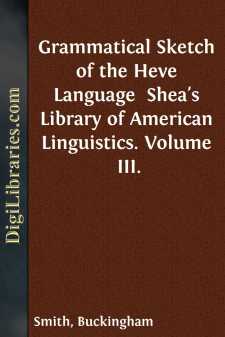Categories
- Antiques & Collectibles 13
- Architecture 36
- Art 48
- Bibles 22
- Biography & Autobiography 813
- Body, Mind & Spirit 138
- Business & Economics 28
- Children's Books 12
- Children's Fiction 9
- Computers 4
- Cooking 94
- Crafts & Hobbies 4
- Drama 346
- Education 46
- Family & Relationships 57
- Fiction 11821
- Games 19
- Gardening 17
- Health & Fitness 34
- History 1377
- House & Home 1
- Humor 147
- Juvenile Fiction 1873
- Juvenile Nonfiction 202
- Language Arts & Disciplines 88
- Law 16
- Literary Collections 686
- Literary Criticism 179
- Mathematics 13
- Medical 41
- Music 40
- Nature 179
- Non-Classifiable 1768
- Performing Arts 7
- Periodicals 1453
- Philosophy 64
- Photography 2
- Poetry 896
- Political Science 203
- Psychology 42
- Reference 154
- Religion 505
- Science 126
- Self-Help 81
- Social Science 81
- Sports & Recreation 34
- Study Aids 3
- Technology & Engineering 59
- Transportation 23
- Travel 463
- True Crime 29
Grammatical Sketch of the Heve Language Shea's Library of American Linguistics. Volume III.
by: Buckingham Smith
Categories:
Description:
Excerpt
PART I: ORTHOGRAPHY.
It has been thought proper to use nineteen characters in the language, among which are not included f, j, k, w, x, y, nor l, although the sound of l is somewhat heard in the soft enunciation given by the Indian to the letter r.
The k is sufficiently supplied in the syllabic sounds que and qui, where the u is silent, although gue and gui are each of two syllables. There has been a disposition to omit the g also, the sound of which, as in go, if the natives had not originally, they certainly possess at present, got from the Spaniards. This should excuse its appearance here. The sound of z is strong as heard in fits.
The vowels are sounded as in tar, bear, silk, doe, rue.
SUBSTANTIVE.
Substantives in this language are declined without the use of articles.
2. Those which may be called verbal, from their origin in verbs, are much used: hiósguadauh, painting, or writing, is the passive (is painted) of the present active hiósguan, I paint. They have their times: hiósguadauh is in the present, expressing the picture I form now of the passive preterite hiósguacauh, the work I have executed, of which hiósguatzidaugh, the picture I will make, is the future passive: and when to these verbal substantives is added the particle gua, it denotes place, as, No hiósguadauhgua, the place where I paint, etc.
GUA.
3. But words signifying kindred, have their termination usually in gua also, for which
.SIVEN, RINA.
4, 5. Other verbal substantives, signifying instruments, are made from the future active: thus, the verb métecan, I chop, having métetze in the future, receives siven in lieu of the final syllable, and makes the substantive, métesiven, axe or tool with which to chop. Many of these words likewise terminate in rina, as bÐÑcusirina, flute, from bÐÑcudan, I whistle, and bÐÑhirina, shovel, from bihán, I scrape.
RAGUA, SURA.
6, 7. Many abstract nouns are formed by the addition of the particle ragua, as váde, joyously; váderagua, joy; déni, good; déniragua, goodness; dóhme, man, or people; dóhmeragua, humanity; and so diósragua, divinity. Others, substantive nouns, applied to certain places end in súra, as, omásúra, canebrake, from om, cane, and súra, in or among; huérigosúra, reedfield; húparosúra, mesquitscrub: and so a town is called Opósúra, because it is among some trees called opó, elm.
8. The verbs are substantives likewise, and as such are declined as much so as the same words are conjugated when verbs: thus, nemútzan, I bewitch, is also wizard, and hiósguan, I write, is scrivener; but it is to be observed of these substantives, as well as of those which end in daugh, that they too have equally their times, as nemútzan, the wizard—that is now, in the present; nemútzari, the preterite that has; nemútzatze, the future that will, with the difference that these terminations are active, while those in daugh, etc., are passive.
TERI, EI, RAVE, E, I, O, U.
9, 10, 11, 12. The many adjective nouns ending in téri, and ei, signify quality, as, bavitéri, elegant; aresumetéri, different or distinct; tasúquei, narrow; asóquei, thick; sútei, white; and so of the rest signifying color....


